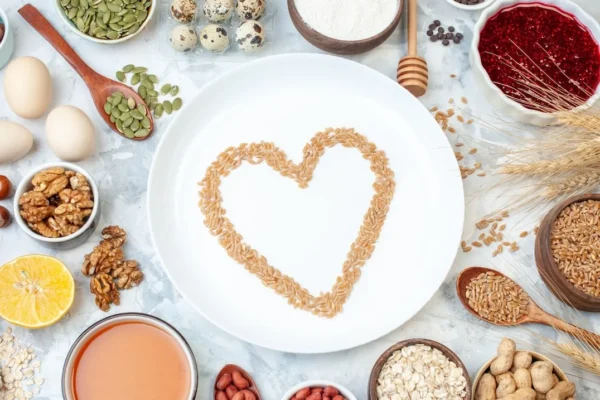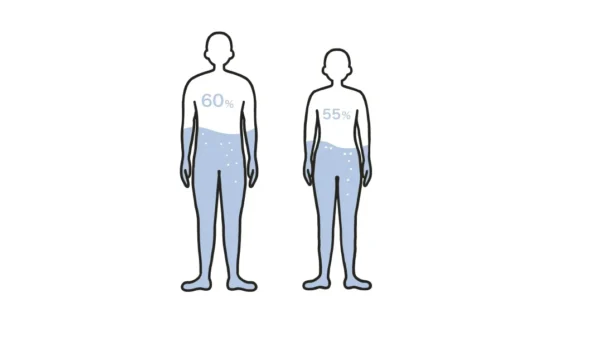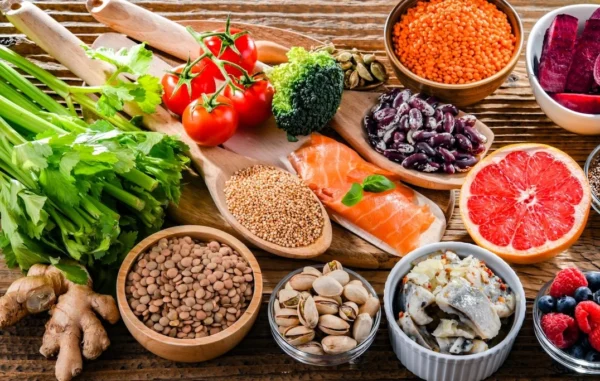High-fiber foods are plant-based carbohydrates that your body cannot digest. They offer important benefits in many areas from heart health to digestive system, from blood sugar balance to weight control. Adequate fiber intake reduces the risk of arterial hardening by lowering bad cholesterol levels and improves your overall well-being by supporting intestinal health. Fiber is one of the fundamental pillars of healthy nutrition and is vital for people of all ages.
High-fiber foods act like a sponge in your digestive system, binding cholesterol and toxins and helping to eliminate them from the body. In this article, we will comprehensively discuss what high-fiber foods are, their types, how much your daily need is, which foods contain them, and how you can include them in your daily diet.
- What are High-Fiber Foods and Why are They Important?
- How Much is the Daily Fiber Need?
- What are High-Fiber Foods?
- How Much Fiber is in Which Food?
- What are the Health Benefits of High-Fiber Foods?
- What Can Fiber Deficiency Lead To?
- How Do You Include More Fiber in Your Diet?
- When Should You Consider Fiber Supplements?
What are High-Fiber Foods and Why are They Important?
High-fiber foods are plant-based nutrients that are not absorbed in your digestive system and do not provide energy to your body, but are vital for your digestive health and overall well-being. Fiber slows down the digestion process, increasing the feeling of fullness, preventing sudden spikes in blood sugar, and helping to lower cholesterol levels. It also regulates your bowel movements, preventing problems such as constipation.
Nutrition experts divide fiber into two main categories: soluble fiber and insoluble fiber. Soluble fiber takes on a gel-like consistency in your digestive system, binding cholesterol and sugar. Insoluble fiber protects your digestive health by accelerating the movement of food in your intestines. Therefore, it is important not only to consume fiber-rich foods but also to prefer foods containing different types of fiber.
How Much is the Daily Fiber Need?
Your daily fiber need varies according to your age and gender. Generally, it is recommended that a healthy adult consume between 25 and 30 grams of fiber per day. However, the daily fiber intake of an average person usually falls well below this target. Adequate fiber intake is very important for protecting your heart health, regulating your digestive system, and reducing your risk of chronic diseases.
More concrete information about your daily fiber need:
- For women: Approximately 25 grams per day.
- For men: Approximately 38 grams per day.
- For women over 50: Approximately 21 grams per day.
- For men over 50: Approximately 30 grams per day.
Reaching these goals is possible by simply reviewing your diet. For example, you can approach this goal by adding a whole grain product and plenty of vegetables to each main meal.
What are High-Fiber Foods?
High-fiber foods are nutrients that support the digestive system and protect intestinal health. Vegetables, fruits, whole grains, legumes, nuts, and seeds are rich in fiber. Especially foods such as broccoli, spinach, carrots, apples, pears, oats, whole wheat bread, chickpeas, and flaxseed stand out with their high fiber content.
You can include the following foods in your daily diet to consume more fiber:
High-fiber whole grains:
Oats, bran bread, bulgur, quinoa, rye bread, whole wheat pasta, and brown rice are healthy grains with high fiber content.
Fibrous vegetables:
Green vegetables such as broccoli, carrots, spinach, Brussels sprouts, as well as kale, chard, beets, sweet potatoes, and Jerusalem artichokes are fiber source vegetables that support your digestive system.
High-fiber fruits:
Fresh fruits such as apples, pears, strawberries, and avocados, as well as fruits such as dried figs, dried apricots, dates, kiwi, and pineapple are high-fiber foods that improve your intestinal health.
High-fiber legumes:
Legumes such as lentils, chickpeas, beans, white beans, broad beans, and black-eyed peas are healthy foods that contain both protein and high amounts of fiber.
Fiber source nuts and seeds:
Almonds, chia seeds, flaxseeds, walnuts, hazelnuts, pistachios, pumpkin seeds, sunflower seeds, and sesame seeds are high-fiber snacks that support heart health.
A bowl of oatmeal can meet approximately 40% of your daily fiber need.
How Much Fiber is in Which Food?
Knowing how much fiber which foods contain to increase your fiber intake provides great convenience when creating your nutrition plan. You can track portion sizes and fiber content to reach your daily fiber goal. Below, you can find the average fiber content of some of the most common fiber sources.
High-fiber foods and their average fiber content:
Legumes:
- 1 cup lentils (cooked): 15-16 grams
- 1 cup chickpeas (cooked): 12-13 grams
- 1 cup black beans (cooked): 15 grams
Grains:
- 1 cup oatmeal (cooked): 4 grams
- 1 slice whole wheat bread: 2-3 grams
- 1 cup brown rice (cooked): 3.5 grams
Fruits:
- 1 medium apple (with skin): 4.5 grams
- 1 medium pear (with skin): 5.5 grams
- 1 cup raspberries: 8 grams
- 1 banana: 3 grams
Vegetables:
- 1 cup broccoli (cooked): 5 grams
- 1 cup Brussels sprouts (cooked): 4 grams
- 1 medium sweet potato (with skin): 4 grams
- 1 cup asparagus (cooked): 4 grams
Nuts and Seeds:
- 1 handful of almonds (23 pieces): 3.5 grams
- 2 tablespoons chia seeds: 10 grams
- 1 tablespoon flaxseed: 3 grams
What are the Health Benefits of High-Fiber Foods?
Regular fiber intake reduces the risk of cardiovascular diseases such as heart attack and stroke, while helping beneficial bacteria in your digestive system multiply, strengthening your intestinal health. Additionally, high-fiber foods keep you full for a long time, making weight control easier and reducing diabetes risk.
The main benefits of high-fiber foods are:
Protecting Heart Health:
Soluble fiber helps bind cholesterol and eliminate it from the body, lowering bad (LDL) cholesterol. This reduces the risk of arterial hardening (atherosclerosis), lowering the risk of heart attack and stroke.
Blood Sugar Control:
Fiber slows the digestion of carbohydrates and prevents sudden spikes in blood sugar. This plays an important role in preventing and managing type 2 diabetes.
Digestive System Health:
Insoluble fiber increases stool volume, regulating bowel movements and preventing constipation. It also strengthens your digestive health by feeding the intestinal microbiota (beneficial bacteria).
Weight Control:
High-fiber foods provide a longer feeling of fullness and help you eat less. This makes it easier to lose weight and maintain your ideal weight.
Reducing Colon Cancer Risk:
There is scientific evidence that regular fiber intake reduces the risk of colon cancer.
What Can Fiber Deficiency Lead To?
Insufficient fiber consumption can lead to various health problems:
- Can cause cholesterol levels to rise
- Blood sugar control may be impaired
- Risk of weight gain and obesity increases
- Intestinal sluggishness and constipation may occur
- Risk of heart disease may increase
Especially in individuals with existing problems such as heart failure or atrial fibrillation, fiber deficiency can accelerate the progression of diseases.
How Do You Include More Fiber in Your Diet?
Increasing your fiber intake is easier than you think and you can start with small changes. You can prefer whole wheat bread or oatmeal instead of white bread for breakfast, and increase your vegetable portions in your lunch and dinner meals. Adding legumes or nuts to your salads, consuming fruit or a handful of nuts for snacks are also practical ways to increase your fiber intake.
Practical tips for including more fiber in your daily diet:
Strengthen Your Breakfast:
You can start the day with oatmeal or prefer whole grain cereals. You can further increase the fiber amount by adding fruit or seeds on top.
Switch to Whole Grains:
Use brown rice, whole wheat pasta, or bulgur instead of white rice and pasta.
Consume Fruits with Their Peels:
Eating fruits such as apples and pears with their peels significantly increases your fiber intake.
Benefit from Legumes:
You should consume legumes more frequently through ways such as lentil soup, chickpea dishes, or adding beans to salads.
Use Nuts and Seeds:
You can add chia seeds, flaxseeds, almonds, or walnuts to your yogurt, salad, or snacks.
When Should You Consider Fiber Supplements?
If you think you cannot get enough fiber in your daily diet, you can consider using fiber supplements by consulting a health professional. However, remember that supplements cannot replace natural foods and you should always support your diet with fiber-rich foods. You should not forget that you need to drink plenty of water when using fiber supplements and that sudden fiber increase can cause bloating and gas.
Reference: High-Fiber Foods







